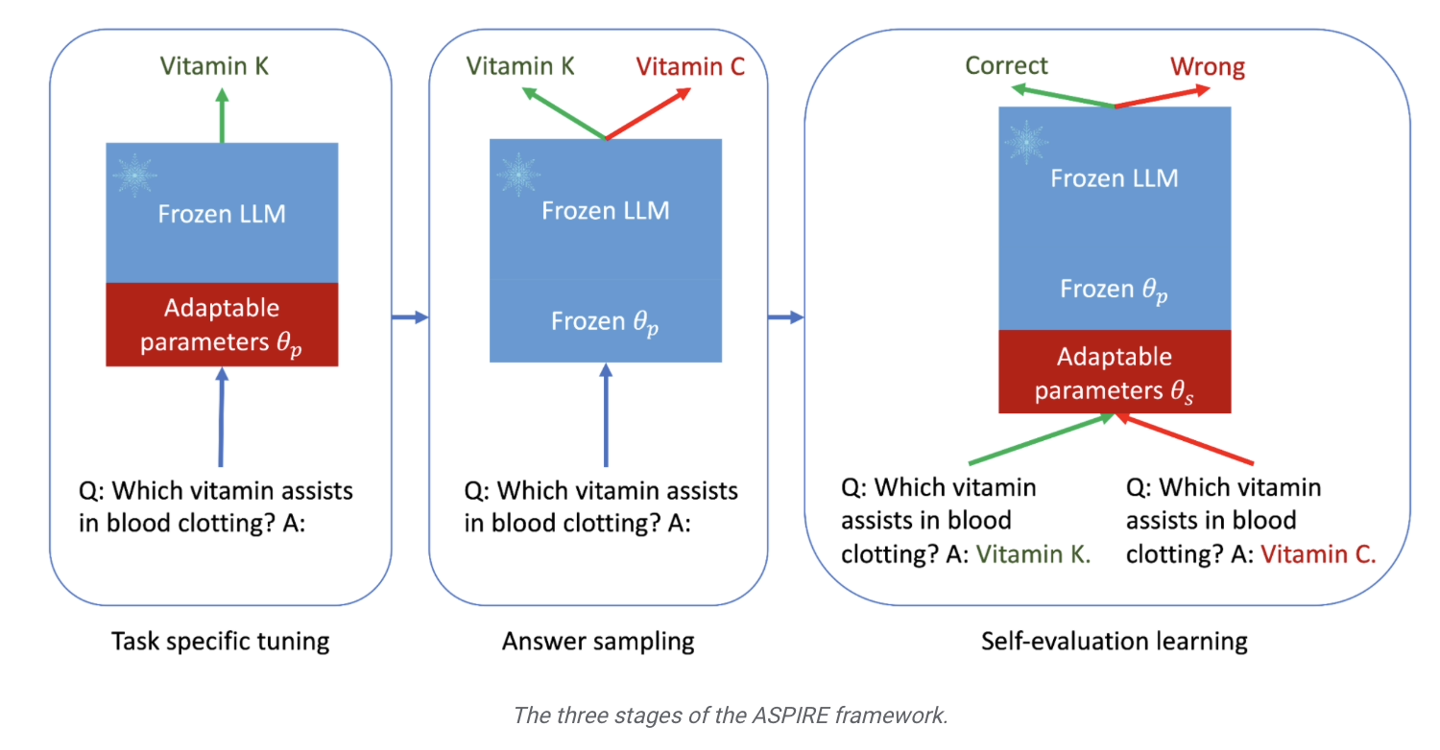 Technology peripherals
Technology peripherals
 AI
AI
 Google releases ASPIRE, a model training framework that allows AI to independently judge output accuracy
Google releases ASPIRE, a model training framework that allows AI to independently judge output accuracy
Google releases ASPIRE, a model training framework that allows AI to independently judge output accuracy

Google recently issued a press release announcing the launch of the ASPIRE training framework, specially designed for large language models. This framework aims to improve the selective prediction capabilities of AI models.

Google mentioned that large language models are developing rapidly in natural language understanding and content generation, and have been used to build various innovative applications, but they must be used in high-risk applications It is still inappropriate in decision-making situations. This is due to the uncertainty and possibility of "hallucination" in model predictions. Therefore, Google has developed an ASPIRE training framework, which introduces a "credibility" mechanism to a series of models, that is - the model will output a series of answers, Each answer will have a probability of being correct score .

▲ Picture source Google press release (the same below)
At the technical level, the training framework can be divided into three stages: specific task adjustment, answer Sampling and self-assessment learning.
The "specific task adjustment" stage is to conduct in-depth training of large-scale language models that have received basic training, focusing on strengthening the prediction ability of the model. Researchers mainly introduce a series of adjustable parameters to the model and fine-tune the pre-trained language model on the training data set of specific tasks, thereby improving the model's prediction performance and allowing the model to better solve specific problems.

The second stage is "answer sampling". After specific fine-tuning, the model can use the previously learned adjustable parameters to generate different answers for each training question. and create datasets for self-assessment learning, generating a range of answers with high confidence. The researchers also used the "Beam Search" method and the Rouge-L algorithm to evaluate the quality of the answers, and re-entered the generated answers and scores into the model to start the third stage.

In the third stage of "self-evaluation learning", the researchers added a set of adjustable parameters to the model specifically to improve the model's self-evaluation capabilities. The goal of this stage is to let the model learn to "judge the accuracy of the output answer by itself", so that when the large language model generates the answer, it will also attach the correct probability score of the answer.
Google researchers used three question and answer data sets, CoQA, TriviaQA and SQuAD, to verify the results of the ASPIRE training framework. It is said that "the OPT-2.7B small model adjusted by ASPIRE performs far better than the larger OPT- 30B Model”. The experimental results also show that with appropriate adjustments, even a small language model can surpass a large language model in some scenarios.

The researchers concluded that ASPIRE framework training can significantly improve the output accuracy of large language models, even for smaller models, after fine-tuning. “Accurate and Confident” Forecast.
The above is the detailed content of Google releases ASPIRE, a model training framework that allows AI to independently judge output accuracy. For more information, please follow other related articles on the PHP Chinese website!

Hot AI Tools

Undresser.AI Undress
AI-powered app for creating realistic nude photos

AI Clothes Remover
Online AI tool for removing clothes from photos.

Undress AI Tool
Undress images for free

Clothoff.io
AI clothes remover

AI Hentai Generator
Generate AI Hentai for free.

Hot Article

Hot Tools

Notepad++7.3.1
Easy-to-use and free code editor

SublimeText3 Chinese version
Chinese version, very easy to use

Zend Studio 13.0.1
Powerful PHP integrated development environment

Dreamweaver CS6
Visual web development tools

SublimeText3 Mac version
God-level code editing software (SublimeText3)

Hot Topics
 1378
1378
 52
52
 How to optimize the performance of debian readdir
Apr 13, 2025 am 08:48 AM
How to optimize the performance of debian readdir
Apr 13, 2025 am 08:48 AM
In Debian systems, readdir system calls are used to read directory contents. If its performance is not good, try the following optimization strategy: Simplify the number of directory files: Split large directories into multiple small directories as much as possible, reducing the number of items processed per readdir call. Enable directory content caching: build a cache mechanism, update the cache regularly or when directory content changes, and reduce frequent calls to readdir. Memory caches (such as Memcached or Redis) or local caches (such as files or databases) can be considered. Adopt efficient data structure: If you implement directory traversal by yourself, select more efficient data structures (such as hash tables instead of linear search) to store and access directory information
 How to implement file sorting by debian readdir
Apr 13, 2025 am 09:06 AM
How to implement file sorting by debian readdir
Apr 13, 2025 am 09:06 AM
In Debian systems, the readdir function is used to read directory contents, but the order in which it returns is not predefined. To sort files in a directory, you need to read all files first, and then sort them using the qsort function. The following code demonstrates how to sort directory files using readdir and qsort in Debian system: #include#include#include#include#include//Custom comparison function, used for qsortintcompare(constvoid*a,constvoid*b){returnstrcmp(*(
 How to set the Debian Apache log level
Apr 13, 2025 am 08:33 AM
How to set the Debian Apache log level
Apr 13, 2025 am 08:33 AM
This article describes how to adjust the logging level of the ApacheWeb server in the Debian system. By modifying the configuration file, you can control the verbose level of log information recorded by Apache. Method 1: Modify the main configuration file to locate the configuration file: The configuration file of Apache2.x is usually located in the /etc/apache2/ directory. The file name may be apache2.conf or httpd.conf, depending on your installation method. Edit configuration file: Open configuration file with root permissions using a text editor (such as nano): sudonano/etc/apache2/apache2.conf
 How Debian OpenSSL prevents man-in-the-middle attacks
Apr 13, 2025 am 10:30 AM
How Debian OpenSSL prevents man-in-the-middle attacks
Apr 13, 2025 am 10:30 AM
In Debian systems, OpenSSL is an important library for encryption, decryption and certificate management. To prevent a man-in-the-middle attack (MITM), the following measures can be taken: Use HTTPS: Ensure that all network requests use the HTTPS protocol instead of HTTP. HTTPS uses TLS (Transport Layer Security Protocol) to encrypt communication data to ensure that the data is not stolen or tampered during transmission. Verify server certificate: Manually verify the server certificate on the client to ensure it is trustworthy. The server can be manually verified through the delegate method of URLSession
 Debian mail server SSL certificate installation method
Apr 13, 2025 am 11:39 AM
Debian mail server SSL certificate installation method
Apr 13, 2025 am 11:39 AM
The steps to install an SSL certificate on the Debian mail server are as follows: 1. Install the OpenSSL toolkit First, make sure that the OpenSSL toolkit is already installed on your system. If not installed, you can use the following command to install: sudoapt-getupdatesudoapt-getinstallopenssl2. Generate private key and certificate request Next, use OpenSSL to generate a 2048-bit RSA private key and a certificate request (CSR): openss
 How debian readdir integrates with other tools
Apr 13, 2025 am 09:42 AM
How debian readdir integrates with other tools
Apr 13, 2025 am 09:42 AM
The readdir function in the Debian system is a system call used to read directory contents and is often used in C programming. This article will explain how to integrate readdir with other tools to enhance its functionality. Method 1: Combining C language program and pipeline First, write a C program to call the readdir function and output the result: #include#include#include#includeintmain(intargc,char*argv[]){DIR*dir;structdirent*entry;if(argc!=2){
 Debian mail server firewall configuration tips
Apr 13, 2025 am 11:42 AM
Debian mail server firewall configuration tips
Apr 13, 2025 am 11:42 AM
Configuring a Debian mail server's firewall is an important step in ensuring server security. The following are several commonly used firewall configuration methods, including the use of iptables and firewalld. Use iptables to configure firewall to install iptables (if not already installed): sudoapt-getupdatesudoapt-getinstalliptablesView current iptables rules: sudoiptables-L configuration
 How to learn Debian syslog
Apr 13, 2025 am 11:51 AM
How to learn Debian syslog
Apr 13, 2025 am 11:51 AM
This guide will guide you to learn how to use Syslog in Debian systems. Syslog is a key service in Linux systems for logging system and application log messages. It helps administrators monitor and analyze system activity to quickly identify and resolve problems. 1. Basic knowledge of Syslog The core functions of Syslog include: centrally collecting and managing log messages; supporting multiple log output formats and target locations (such as files or networks); providing real-time log viewing and filtering functions. 2. Install and configure Syslog (using Rsyslog) The Debian system uses Rsyslog by default. You can install it with the following command: sudoaptupdatesud



